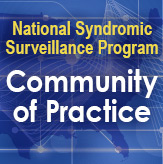Syndromic Surveillance of Non-traumatic Dental Conditions in Idaho Core Areas
Injury, Collaboration

Access to dental care is a public health problem in Idaho because most of the state is experiencing a shortage of dental health professionals. Anecdotal evidence indicates that some Idahoans compensate for the shortage by seeking dental care in emergency departments (EDs). Because EDs treat symptoms—not the cause—of these problems, patients frequently return to EDs for the same problem, increasing the cost to patients, insurance companies, and taxpayers.
Epidemiologists in Idaho are using syndromic surveillance to better understand this problem. With near-real time monitoring, epidemiologists have been able to examine trends and identify non-traumatic dental care visits by sex and age group. By quantifying the scope of the problem, they have moved discussion of ED dental care visits beyond anecdotal reports. The Idaho Health Department’s Oral Health Program is partnering with dental practitioners, dental insurance providers, and other oral health professionals to address the issue and is looking for opportunities to engage partners from mental health and substance abuse treatment.
Syndromic surveillance has filled a known knowledge gap in Idaho about the use of EDs for non-traumatic dental conditions. By quantifying the problem, they moved from anecdotes to insights that are leading to solutions. Funding from the National Syndromic Surveillance Program supports the use of syndromic surveillance in improving the nation’s public health.
Public Health Problem
Access to dental care is a public health problem in Idaho because most of the state is experiencing a shortage of dental health professionals. The Idaho Oral Health program has anecdotal evidence that some Idahoans compensate for this shortage by seeking dental care in emergency departments (EDs). Although ED use for dental care caused by oral trauma can be expected, and is appropriate, the use of EDs for non-traumatic dental care may indicate use of the wrong resources.
EDs generally provide only palliative care for oral problems (e.g., antibiotics and pain medication). EDs address the symptoms—not the cause—of these problems. This results in patients frequently returning to EDs for the same problem, which, in turn, raises cost to patients, insurance companies, and taxpayers. A large proportion of oral health-related ED visits are not for trauma but for dental conditions more appropriately treated outside the ED. Consequently, Idaho turned to syndromic surveillance, the state’s only source of ED data, to evaluate what type of patient visits Idaho EDs for non-traumatic dental care and how often.
Actions Taken
Given the lack of data available to understand this problem, the chronic disease epidemiologist approached the Idaho Oral Health program about the potential of syndromic surveillance data. The Idaho Oral Health program included activities in its grant application to explore the use of syndromic surveillance data to characterize ED use for non-traumatic dental care visits. The program felt that, if successfully able to characterize these visits, syndromic surveillance data would finally provide an understanding of the extent of the problem within the state and help to identify potential solutions. Consequently, the chronic disease epidemiologist initiated an analysis of syndromic surveillance data for non-traumatic dental care visits.
The Idaho Oral Health program staff is the primary audience for this work, along with the program’s key stakeholders. Other state and local health departments have used databases such as the State Emergency Department Database (SEDD) or state ED databases to monitor non-traumatic dental conditions; however, these data sources do not exist in Idaho. To our knowledge, Idaho is one of the few states using a syndromic surveillance system to assess ED use for non-traumatic dental conditions.
This activity began in spring 2017 with the development of an ESSENCE* query to identify non-traumatic dental care visits. The initial query was adapted from guidance developed by the Association of State and Territorial Dental Directors (ASTDD) and input from the Idaho Oral Health Program to focus on specific areas of programmatic interest. Query results were stratified to examine distribution of visits by sex and age groups as well as trends of visits over time.
*Electronic Surveillance System for the Early Notification of Community-based Epidemics
Outcome
This surveillance activity is still in its early stages. To date, the primary result has been to move discussions of ED dental care visits beyond anecdotal reports to a quantifiable understanding of the scope of the problem and to provide initial insight into demographic characterizations of who makes these types of visits. Analysis of ED visits from June 4, 2017, through September 30, 2017, revealed non-traumatic dental care visits were roughly 1.5%–2% of all ED visits during the timeframe. Most visits occurred among people 20–49 years of age. About 3% of visits resulted in hospital admission. Lastly, a substantial portion of non-traumatic dental care visits also resulted in ICD-10 codes associated with mental health or substance use.
Results were presented to both the Idaho Oral Health Program and the program’s key stakeholders, which include dental practitioners, dental insurance providers, and professionals from various fields working on public health issues surrounding oral health. These presentations have generated ideas about partnering with those working in mental health or substance use and have moved discussion of ED use for oral health problems from being a relatively minor topic, because of lack of data, to one about whether this issue should be addressed systematically. A major dental health insurance provider has shown interest in collaborating to reduce the number of ED admissions related to non-traumatic dental care. The Idaho Oral Health Program plans to continue using syndromic surveillance to monitor ED visits for non-traumatic dental care and to exploring effective ways to reduce these visits. Further, the Idaho Oral Health program is exploring activities other states have engaged in to address this issue.
Lessons Learned
- Syndromic data is oftentimes the only available data that is timely. Use it to characterize a known problem. Although Idaho’s syndromic surveillance of non-traumatic dental conditions has not yet produced a measurable impact on public health practice, the use of syndromic surveillance has proved invaluable in filling a known knowledge gap in Idaho regarding the use of emergency departments for non-traumatic dental conditions.
- The near real-time nature of syndromic data proves helpful in understanding how a state’s medical services are being used. Idaho’s syndromic surveillance system has proven to be an innovative way for the Idaho Oral Health Program to understand medical service usage within the state. In this instance, there was anecdotal evidence that Idahoans were using emergency departments for non-traumatic dental care, but data were needed to measure the extent of the problem.
Contacts
Bureau of Communicable Disease Prevention
Epidemiology Program
epimail@dhw.idaho.gov
Office of Public Health Data, Surveillance, and Technology
Division of Health Informatics and Surveillance
www.cdc.gov/nssp
This success story shows how NSSP
- Improves Data Representativeness
- Improves Data Quality, Timeliness, and Use
- Strengthens Syndromic Surveillance Practice
- Informs Public Health Action or Response
The findings and outcomes described in this syndromic success story are those of the authors and do not necessarily represent the official position of the National Syndromic Surveillance Program or the Centers for Disease Control and Prevention.
